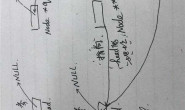|
#include<stdio.h> 有的说gets会,有的说不会 但是如果我把里面的gets全改为scanf |
|
| 30分 |
Format Specification Fields: scanf and wscanf Functions
A format specification has the following form: %[*] [width] [{h | l | I64 | L}]type The format argument specifies the interpretation of the input and can contain one or more of the following: White-space characters: blank (“” “”); tab (“”\t””); or newline (“”\n””). A white-space character causes scanf to read, but not store, all consecutive white-space characters in the input up to the next non–white-space character. One white-space character in the format matches any number (including 0) and combination of white-space characters in the input. Non–white-space characters, except for the percent sign (%). A non–white-space character causes scanf to read, but not store, a matching non–white-space character. If the next character in stdin does not match, scanf terminates. Format specifications, introduced by the percent sign (%). A format specification causes scanf to read and convert characters in the input into values of a specified type. The value is assigned to an argument in the argument list. When the first format specification is encountered, the value of the first input field is converted according to this specification and stored in the location that is specified by the first argument. The second format specification causes the second input field to be converted and stored in the second argument, and so on through the end of the format string. An input field is defined as all characters up to the first white-space character (space, tab, or newline), or up to the first character that cannot be converted according to the format specification, or until the field width (if specified) is reached. If there are too many arguments for the given specifications, the extra arguments are evaluated but ignored. The results are unpredictable if there are not enough arguments for the format specification. Each field of the format specification is a single character or a number signifying a particular format option. The type character, which appears after the last optional format field, determines whether the input field is interpreted as a character, a string, or a number. The simplest format specification contains only the percent sign and a type character (for example, %s). If a percent sign (%) is followed by a character that has no meaning as a format-control character, that character and the following characters (up to the next percent sign) are treated as an ordinary sequence of characters, that is, a sequence of characters that must match the input. For example, to specify that a percent-sign character is to be input, use %%. An asterisk (*) following the percent sign suppresses assignment of the next input field, which is interpreted as a field of the specified type. The field is scanned but not stored. |
|
gets, _getws
Get a line from the stdin stream. char *gets( char *buffer ); wchar_t *_getws( wchar_t *buffer ); Routine Required Header Compatibility For additional compatibility information, see Compatibility in the Introduction. Libraries LIBC.LIB Single thread static library, retail version Return Value Each of these functions returns its argument if successful. A NULL pointer indicates an error or end-of-file condition. Use ferror or feof to determine which one has occurred. Parameter buffer Storage location for input string Remarks The gets function reads a line from the standard input stream stdin and stores it in buffer. The line consists of all characters up to and including the first newline character (“”\n””). gets then replaces the newline character with a null character (“”\0″”) before returning the line. In contrast, the fgets function retains the newline character. _getws is a wide-character version of gets; its argument and return value are wide-character strings. Generic-Text Routine Mappings TCHAR.H Routine _UNICODE & _MBCS Not Defined _MBCS Defined _UNICODE Defined Example /* GETS.C */ #include <stdio.h> void main( void ) printf( “Input a string: ” ); Output Input a string: Hello! Stream I/O Routines See Also fgets, fputs, puts |
|
|
我想请问,我连用俩个scanf
#include<stdio.h> void main() { int i = 1; scanf(“%d”, &i); scanf(“%d”,&i); printf(“%d\n”,i); } 为什么我没有清空缓存区也不跳过 |
|
|
答案在#1楼。 |
|
|
你输入第一个整数后,回车 |
|
|
纠正: |
|




